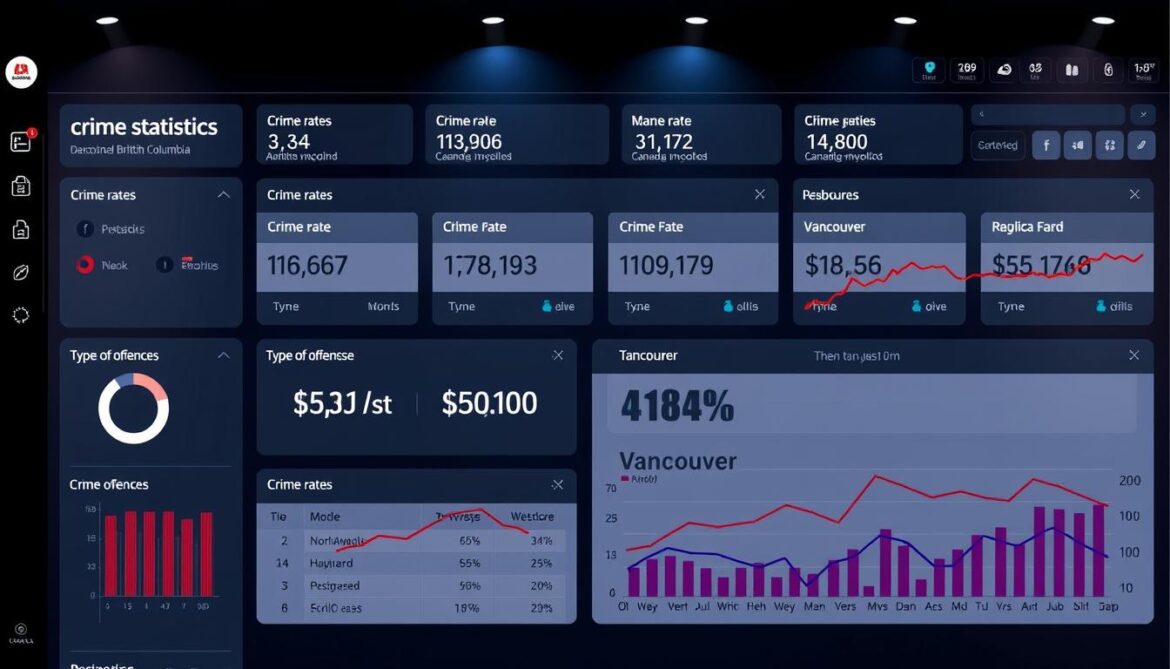Vancouver’s crime landscape is a complex issue, with violent crime rates experiencing a notable decline. According to recent crime statistics, violent crime fell by seven percent in the first half of this year compared to 2023. However, it remains above pre-pandemic levels, sparking concerns among residents and law enforcement.
The crime data is crucial in understanding the trends and patterns in Vancouver’s crime rates. The Vancouver Police Department uses crime statistics to identify areas of concern, allocate resources effectively, and measure the success of their initiatives. By examining the crime trends and data, we can gain a deeper understanding of the factors influencing crime in Vancouver and how they relate to Canada’s broader Criminal Code.
This analysis will provide insights into the current state of crime in Vancouver, BC, and its position within Canada’s crime landscape.
Current Crime Trends in Vancouver BC
Recent crime statistics in Vancouver BC reveal a complex picture of safety and crime trends in the city. In the first six months of this year, the city reported 2,837 violent crimes, compared to 3,051 in 2023, indicating a 7% decrease in violent crime rates.

Recent Violent Crime Statistics
The violent crime category includes homicide, attempted murder, assaults, robbery, and sexual offenses. While the overall trend shows a decline, with 2,837 violent crimes reported in the first half of this year, the numbers remain above pre-pandemic levels, with 2,654 violent crimes reported in the first half of 2019.
Breaking down violent crime by category provides a nuanced understanding of the crime trends in Vancouver. The data indicates a shift in the types of crimes being committed, with some categories experiencing a decline while others remain steady.
Geographic Distribution of Crime in Vancouver
The geographic distribution of crime in Vancouver is not uniform, with some areas experiencing higher crime rates than others. Downtown Vancouver saw a slight increase in violent crimes, with a 2.5% rise, while neighborhoods west of Cambie Street experienced a significant 22.8% decline in violent crimes.
This variation highlights the importance of analyzing crime trends at a local level to understand the underlying factors contributing to these changes. By examining the crime statistics in different neighborhoods, law enforcement can develop targeted strategies to address specific crime concerns.
Understanding Canada’s Criminal Code
The Criminal Code of Canada serves as the foundation for the country’s legal system, outlining the structure and classification of criminal offences. It provides a comprehensive framework for understanding and prosecuting crimes across the nation.
Structure and Classification of Offences
Canada’s Criminal Code categorizes offences into different classes, primarily summary and indictable offences. Summary offences are considered less severe and are typically punished with lighter sentences, while indictable offences are more serious and can result in harsher penalties. The classification of an offence significantly impacts its prosecution and sentencing. The Code also outlines various crime trends and patterns, helping law enforcement agencies to track and address criminal activities effectively.
The hierarchical organization of the Criminal Code ensures that criminal offences are handled systematically. This classification is crucial for police and legal professionals to understand the severity and implications of various crimes.
How Crime is Reported and Measured in Canada
In Canada, crime data is collected and reported through standardized systems, primarily by Statistics Canada and local police departments. The Uniform Crime Reporting (UCR) system plays a vital role in standardizing crime reports across different jurisdictions. Crime severity indexes are calculated to provide a nuanced understanding of crime trends, going beyond raw numbers to reflect the complexity of criminal activities.
| Crime Category | Reporting Method | Data Source |
|---|---|---|
| Violent Crimes | UCR System | Statistics Canada |
| Property Crimes | UCR System | Local Police Departments |
| Other Offences | UCR System | Statistics Canada & Local Police |

Factors Influencing Crime Rate in Vancouver BC
Understanding the factors that influence crime rates in Vancouver BC requires a nuanced examination of socioeconomic and demographic elements. The city’s crime trends are shaped by a complex interplay of various factors, including post-pandemic shifts in criminal activity, socioeconomic conditions, and government initiatives.
Post-Pandemic Crime Pattern Changes
The COVID-19 pandemic has significantly disrupted social patterns and economic stability, affecting different types of criminal behavior in Vancouver’s neighborhoods. For instance, there has been a notable increase in violent crimes in certain areas, potentially linked to substance use disorders and mental health challenges. The pandemic has also exacerbated issues like homelessness and public disorder, particularly in downtown Vancouver.

Government and Police Initiatives
In response to rising public safety concerns, the government and police have introduced various initiatives. Premier David Eby and B.C. Conservative Leader John Rustad have pledged to implement involuntary care for individuals with severe mental health or substance use disorders. For more information on Canada’s crime rate, you can explore Canada’s violent crime rate. The effectiveness of community policing strategies and targeted enforcement efforts is being evaluated to address crime hotspots throughout Vancouver.
| Factor | Influence on Crime Rate | Initiatives |
|---|---|---|
| Socioeconomic Conditions | Affects crime trends through income inequality and unemployment | Economic support programs and job creation |
| Mental Health and Substance Use | Linked to increase in violent crimes and public disorder | Involuntary care for severe cases |
| Police and Community Initiatives | Impacts crime rates through community policing and enforcement | Targeted enforcement and community engagement |
Preventing Crime in Vancouver and Across Canada
Preventing crime in Vancouver and across Canada requires a combination of individual vigilance, community programs, and law enforcement strategies. To effectively reduce crime, it’s crucial to understand the various factors influencing crime rates and trends in the region.
Evidence-based crime prevention programs have shown success in reducing specific types of criminal activity, including property crimes and violent offenses. For instance, the Vancouver Police Department’s use of the GeoDASH Map, an interactive mapping tool, provides neighborhood-specific crime data, helping citizens make informed decisions about personal safety and property protection.
Community engagement plays a vital role in crime prevention, with initiatives such as neighborhood watch programs and citizen reporting systems fostering collaboration between residents and law enforcement agencies. Moreover, addressing the root causes of crime through social programs, educational initiatives, and economic opportunity creation is essential for long-term prevention strategies.
By leveraging data-driven policing strategies and implementing targeted prevention measures, law enforcement can effectively allocate resources to high-risk areas and time periods, ultimately contributing to a decline in crime rates over the years.
As Vancouver and Canada continue to evolve in their approach to crime prevention, emerging trends and technologies will play a significant role in shaping public safety initiatives, ensuring a safer environment for residents and a reduction in crime statistics over time.

